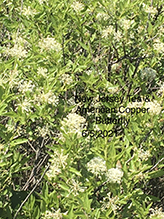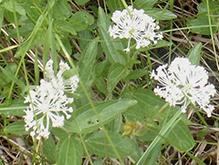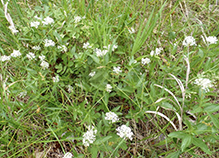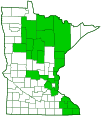narrow-leaved New Jersey tea
(Ceanothus herbaceus)
Conservation • Description • Habitat • Ecology • Use • Distribution • Taxonomy
Conservation Status |
|
|||||||
| IUCN Red List | not listed |
|||||||
| NatureServe | N5 - Secure SNR - Unranked |
|||||||
| Minnesota | not listed |
|||||||
Description |
||
Narrow-leaved New Jersey tea is a low, drought resistant shrub. In the United States it occurs in the northeastern tier of states from Vermont and Virginia west to Minnesota and Illinois, and in the Great Plains and Midwest from Iowa and Arkansas west to Montana and New Mexico. In occurs in southern Canada from Quebec to Manitoba. It is found in prairies, savannas, hillsides, and open woodlands, and on roadsides. It grows under full sun in sandy or rocky soil. It is uncommon and local in Minnesota. Narrow-leaved New Jersey tea is a bushy, compact shrub that rises from a large root system that includes a stout taproot. It can be 24″ to 40″ (60 to 100 cm) tall but in Minnesota it is usually no more than 24″ (60 cm) in height. It sometimes forms clumps but seldom forms colonies. The stems are erect or curving up from the base (ascending) and much branched. They do not root at the nodes. The bark is grayish-brown. Branches are ascending, flexible, and round in cross section. They are not thorn-tipped. First year branches are green to brownish-green and are densely covered with minute, more or less appressed hairs. Older branches are brown or reddish and minutely hairy, eventually becoming hairless or almost hairless. The leaves are alternate, 1″ to 2¾″ (25 to 70 mm) long, and ⅜″ to 1 3⁄16″ (10 to 30 mm) wide. They are on hairy, 1⁄16″ to ¼″ (2 to 6 mm) long stalks (petioles). The leaf blades are herbaceous, not leathery, not resinous, and not aromatic. They are usually narrowly oval (elliptic) to lance-shaped, sometimes egg-shaped or inversely lance-shaped. They are wedge-shaped or rounded at the base and narrowly or broadly pointed at the tip. There are three main veins arising from the base of the blade, a midvein and a pair of secondary veins that are as prominent and sometimes as long as the midvein. The upper surface is dark green, dull, and usually sparsely to moderately covered with short, cobwebby hairs, rarely hairless. The lower surface is pale green and moderately to densely covered with short hairs, rarely hairless. The margins have 22 to 35 rounded, gland-tipped teeth per side. The leaves will shrivel and discolor in dry conditions but fully recover after a rain. The inflorescence is a single umbrella-like, globe-shaped to half globe-shaped, 1 9⁄16″ to 3⅛″ (4 to 8 cm) in diameter cluster of flowers at the end of each main branchlet of the current years growth. The stalk (peduncle) of the inflorescence is usually shorter than the subtending leaf. Each flower is about ¼″ wide. There are 5 outer floral leaves (sepals), 5 petals, 5 stamens, and 1 style. The sepals are white, triangular, curved inward, and 1⁄64″ to 1⁄32″ (0.5 to 1.0 mm) long. The petals are white, spoon-shaped, widely spreading, and 1⁄16″ to ⅛″ (1.5 to 2.5 mm) long. The stamens have white stalks (filaments) and usually dark anthers. The style is white and has 3 lobes. The fruit is a capsule-like, modified drupe with 3 lobes. Mature fruits are black and ⅛″ to 3 ⁄16″ (3 to 5 mm) in diameter. The fruit is a black, capsule-like, 3-lobed, ⅛″ to 3 ⁄16″ (3 to 5 mm) wide, modified drupe with 3 stones. |
||
Height |
||
24″ to 40″ (60 to 100 cm) |
||
Flower Color |
||
White |
||
Similar Species |
||
New Jersey tea (Ceanothus americanus) is a larger plant, up to 40″ (100 cm) in Minnesota. The leaves are larger, longer stalked, and broad, not narrow. The inflorescence is larger, panicle-like clusters on short branchlets in the upper leaf axils. The fruit is unlobed. |
||
Habitat |
||
Moderately dry to dry. Prairies, savannas, hillsides, open woodlands, roadsides. Full or partial sun. Sandy or rocky soil. |
||
Ecology |
||
Flowering |
||
Early June to early July |
||
Pests and Diseases |
||
|
||
Use |
||
|
||
Distribution |
||||
|
Sources |
|||
| 10/22/2021 | ||||
Nativity |
||||
Native |
||||
Occurrence |
||||
Uncommon and local |
||||
Taxonomy |
|||
| Kingdom | Plantae (green algae and land plants) | ||
| Subkingdom | Viridiplantae (green plants) | ||
| Infrakingdom | Streptophyta (land plants and green algae) | ||
| Superdivision | Embryophyta (land plants) | ||
| Division | Tracheophyta (vascular plants) | ||
| Subdivision | Spermatophytina (seed plants) | ||
| Class | Magnoliopsida (flowering plants) | ||
| Subclass | Rosidae | ||
| Superorder | Rosanae | ||
Order |
Rosales (roses, elms, figs, and allies) | ||
Family |
Rhamnaceae (buckthorn) | ||
| Tribe | Rhamneae | ||
Genus |
Ceanothus | ||
| Subgenus | Ceanothus | ||
Subordinate Taxa |
|||
|
|||
Synonyms |
|||
Ceanothus herbaceus var. pubescens Ceanothus ovatus Ceanothus ovatus var. pubescens Ceanothus pubescens |
|||
Common Names |
|||
inland ceanothus Jersey tea narrow-leaved New Jersey tea prairie redroot redroot |
|||
Glossary
Ascending
Growing upward at an angle or curving upward from the base.
Drupe
A fleshy fruit with usually a single hard, stone-like core, like a cherry or peach; a stone fruit.
Elliptic
Narrowly oval, broadest at the middle, narrower at both ends, with the ends being equal.
Filament
On plants: The thread-like stalk of a stamen which supports the anther. On Lepidoptera: One of a pair of long, thin, fleshy extensions extending from the thorax, and sometimes also from the abdomen, of a caterpillar.
Panicle
A pyramidal inflorescence with a main stem and branches. Flowers on the lower, longer branches mature earlier than those on the shorter, upper ones.
Peduncle
In angiosperms, the stalk of a single flower or a flower cluster; in club mosses, the stalk of a strobilus or a group of strobili.
Petiole
On plants: The stalk of a leaf blade or a compound leaf that attaches it to the stem. On ants and wasps: The constricted first one or two segments of the rear part of the body.
Sepal
An outer floral leaf, usually green but sometimes colored, at the base of a flower.
Spreading
Extending nearly horizontal.
Visitor Photos |
|||||
Share your photo of this plant. |
|||||
| This button not working for you? Simply email us at info@MinnesotaSeasons.com. Attach one or more photos and, if you like, a caption. |
|||||
Nancy Falkum |
|||||
New Jersey Tea with American Copper Butterfly (Lower Right) |
|||||
 |
|||||
Luciearl |
|||||
This appears to be a new plant I have not seen before. Growing in the ditch near my woods. |
|||||
 |
 |
||||
MinnesotaSeasons.com Photos |
|||||
|
|||||

Slideshows |
||

Visitor Videos |
|||
Share your video of this plant. |
|||
| This button not working for you? Simply email us at info@MinnesotaSeasons.com. Attach a video, a YouTube link, or a cloud storage link. |
|||
Other Videos |
|||


Created: 7/23/2020
Last Updated:


